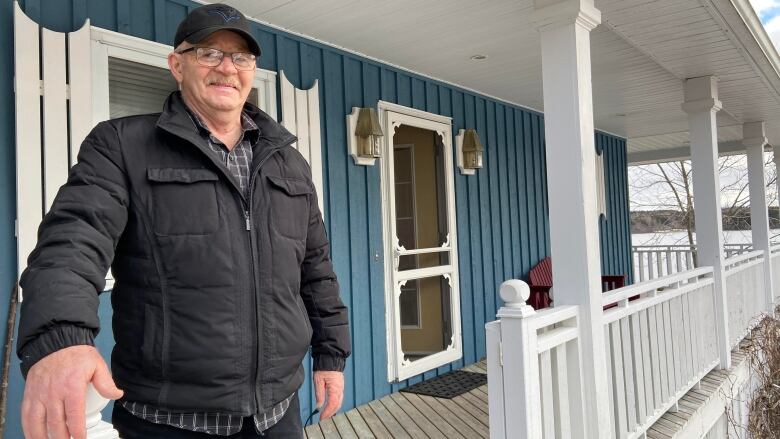What has 2 heads, 2 wings and has been hanging around this N.S. home? No one knows
Bill and Earlene Gill say a two-headed bird visited their Cape Breton backyard at least twice in January

At first, Bill Gill thought there were two birds roaming around his backyard.
But on closer inspection, the Cape Breton man noticed there was only one plump little body withtwo heads, two beaks and two wings.
Gill said both he and his wife, Earlene, saw the feathery forager, which stopped by hishomein the community of Blacketts Lake ineasternCape Breton, N.S., at least twice last month.
"We happened to notice that therewas only two legs on it," said Gill, while looking out over his property.
"They both eat independently, or pecking whatever they're doing there," he said of the bird's two heads. "He's pretty different looking."
Gill said the wild bird appears to be a ruffed grouse. Itfirst arrived about 2 weeks ago,just before dusk. When the couple tried to get closer, the bird flew into an apple tree.
When it visitedagain on Jan. 26, Gill snapped a photograph of the creature on his tablet. He creptwithin a couple metres of it before it flew into the woods, he said.

The greyish-brown bird is described as having two heads of different colours.
"One head is a little smaller than the other one, and it's a little bit lower on the body of it, but it's a darker head it's almost black," said Gill.
"At one point, they turned their heads toward each other."
Searching the internet for answers
After spotting the bird, Gill said he and his wife began scouring the internet for other two-headed creatures.
"I guess you could say it was a shock when you stop and realize what it was," he said.
The retired electrical contractor has been living on the property for almost 30 years. In that time, he's seen coyotes, foxes, geese, ducks and eaglesbut never a two-headed bird.
Gill shared his sighting during The Bird Houron CBC Radio's Information Morning Cape Breton. Thephone-in program airs on the first Monday of each month.
"I wasn't sure I was going to call in ... but I decided I'd better, because it's not something that's very common," Gill said.
Gill said he is keeping his eyes peeled every day,just in case the bird comes back. He hopes some of his neighbours have spotted it, too.
'A long history of 2-headed animals'
Nova Scotia biologists say a two-headed bird is not out of the realm of possibilities.
"I believe it's entirely possible," said Leslie MacLaren, aprofessor emeritus with Halifax-based Dalhousie University's department of animal sciences and aquaculture, which is based in Truro, N.S.
"I think it's pretty rare, but I think it's possible."
MacLarensaid survival rates for suchbirds would be low.Biologists say the anomaly is what's often described as conjoined twins.
"There's a very long history of two-headed animals," said Tamara Franz-Odendaal, a biology professor at Halifax's Mount Saint Vincent University.
"It's fairly rare, but there's two-headed snakes, two-headed cats," Franz-Odendaal said. "For animals, it's mostly the result of inbreeding, so it's quite, quite, rare to see it with wild animals.But yes, it certainly is possible."
Franz-Odendaal said it's also feasible for conjoined twins to develop different patterns of pigmentation.
Andrew Hebda, who retired in 2019 as zoologycurator of the Nova Scotia Museum, said he's checked museumrecords, and there are no recorded provincial sightings of two-headed birds in the wild.
He said there is one record in literature of a two-headed grouse observed in Boston, dating back to the 1890s.
MORE TOP STORIES












_(720p).jpg)


 OFFICIAL HD MUSIC VIDEO.jpg)
.jpg)



























































































